Comments / Questions (46)
![]() Cinzia wrote:
Cinzia wrote:
Buongiorno. Could you, please, explain how stitches can be aumented under the sleeves? Thank you very much Kind regards Cinzia
11.02.2019 - 07:31DROPS Design answered:
Dear Cinzia! Work the first 40-44-49-54-60-66 sts (it depends on your size), work the next 64-67-71-75-80-84 sts and then slip them on a stitch holder (= sleeve), cast on 12 new sts under left sleeve, just like in the video: HERE. Happy knitting!
11.02.2019 - 07:45
![]() Uta wrote:
Uta wrote:
Liebes Drops Team, Ich bin bei den Raglanzunahmen und habe nachgerechnet: nach den Zunahmen in den Krausrippen hatte ich 134M (Gr.M), wie beschrieben. Allerdings verwirren mich die Maschenangaben nach den Raglanzunahmen: wenn ich 1x 16 M zunehmen soll, bin ich bei 150M dann folgen 19x 8M ( insgesamt 302M) und schließlich 4x 8 M ergeben bei mir 332M und nicht 310... Ich habe 15x M zugenommen, jetzt 286M auf der Nadel und keine Ahnung wie ich weitermache. LG
07.02.2019 - 10:51DROPS Design answered:
Liebe Uta, am Ende nehmen Sie nur 1 Mal 8 Maschen nach 4 Runden (dh nicht 4 x 8 M), dh nach 19 x 8 M, stricken Sie noch 3 Runde ohne Zunahme dann arbeiten Sie die letzte Zunahme bei der nächsten Runde. Viel Spaß beim stricken!
07.02.2019 - 11:09
![]() Alice Legrand wrote:
Alice Legrand wrote:
Bonjour, pour le raglan je ne comprends pas la partie qui dit : " et 1 fois dans toutes les tailles tous les 4 tours"? Que signifie dans toutes les tailles? Merci!
06.01.2019 - 23:16DROPS Design answered:
Bonjour Mme Legrand, vous augmentez pour le raglan 1-2-3 fois (cf taille) 2 m de chaque côté de chaque marqueur tous les 2 tours, puis vous augmentez 18-19-21-23 fois 1 m de chaque côté de chaque marqueur tous les 2 tours et enfin 1 fois tous les 4 tours (= 4 tours après la dernière augmentation). Bon tricot!
07.01.2019 - 12:01
![]() Eveline wrote:
Eveline wrote:
Ik heb een vraag over het lijf (ik maak de trui in XL): je moet vanaf de mouwinzet 1x na 4 cm aan elke zijkant meerderen en daarna nog 5x na elke 3 cm. Er staat: na alle meerderingen meet het werk 29 cm, maar volgens mij is dat (1x4)+(5x3)= 19 cm? Of moet ik daarna nog 10 cm breien voordat ik met A1 begin?
03.12.2018 - 16:40DROPS Design answered:
Dag Eveline,
Het is inderdaad de bedoeling dat je door breit tot de aangegeven afmetingen. Dit stond niet aangegeven in het patroon en ik heb het nu aangepast. Veel breiplezier!
06.12.2018 - 10:49
![]() Cecile wrote:
Cecile wrote:
I am at the point when I start the short rows in the back. Is this a wrap and turn? The directions only say turn. I am assuming that after I do the first row of short row (elevation in back) I will purl on the wrong side.
10.11.2018 - 02:19DROPS Design answered:
Dear Cecile, the short rows on the elevation are not worked wrap & turn - see video but you can use this technique if you rather. Happy knitting!
12.11.2018 - 11:03
![]() Heidi Byvold wrote:
Heidi Byvold wrote:
Jeg har prøvd meg på forhøyning for første gang....Får det ikke til å stemme. Når jeg strikker det slik jeg forstår, så blir det to rader mer på venstre side av MB enn på høyre ( sett fra retten). Jeg har prøvd nå å strikke 30 masker rett, snu, strikke 60 m vrangt, snu, strikke 65 m rett, snu, strikke 70 m vrang, snu, strikke 75 rett, snu, strikke 80 m vrang, snu og så rett 40 m til MB. Da får jeg det til å stemme🤔Men det er jo ikke sånn det står i oppskriften?
28.03.2018 - 09:37DROPS Design answered:
Hej Heidi, du skal kun strikke forhøjning over ialt 60 masker, du starter med 20, strikker 40 tilbage, lægger 5 masker på for hver gang du vender til du har strikket over 60 masker. God fornøjelse!
26.04.2018 - 11:02
![]() Roody wrote:
Roody wrote:
Hei! Takk for svar. Det vil hjelpe meg med å fortsette litt videre. Men du mener 1 maske hver 4.omgang x1 etter at man er ferdig med å strikke de 19. Ganger med 1 maske økning på hver side av merket anna hver gang?
29.10.2017 - 08:17DROPS Design answered:
Hej igen, ja det stemmer du øger en gang til efter de 19 gange og sidste gang er det efter 4 pinde. God fornøjelse!
15.11.2017 - 14:04
![]() Roody wrote:
Roody wrote:
Hei! Lurer på hva de mener i det feltet om Raglan og ...hver 4.omgang 1 gang i alle størrelser=288-310-338-366-400-432 mArb måler 20-21-22-23-24-25 cm fra skulder. Hvis man skal i en størrelse M som jeg strikker øke hver 2.omgang med 1 M på hver side av merket, så må man øke med 2 hver 4.omgang i følge oppskriften ikkesant?
28.10.2017 - 15:57DROPS Design answered:
Hei Roody, Du øker (hver 2. pinne) først 2 masker på hver side av merkene x 1; 1 maske på hver side x 19; også 1 maske (hver 4. pinne) x 1. Håper dette hjelper og god fornøyelse!
29.10.2017 - 06:02
![]() Jeanette Orderud wrote:
Jeanette Orderud wrote:
Hei! Jeg får ikke førhøyningen i nakken til å stemme. Ser at dette er blitt rettet, men forstår bare ikke hvordan det kan stemme? Det blir jo ikke likt på begge sider og det skal det vel være?
23.06.2017 - 18:40DROPS Design answered:
Hei Jeanette. Hvilken str strikker du? Når jeg ser på str. S, så har du like mange forhøyninger på hver side. På denne modellen er det forhøyning etter 20 masker (1.gangs det snus) og 25 masker (3.gangs det snus) i den ene siden og 25 masker (2.gangs det snus) og 30 masker (4.gangs det snus) i den andre siden, sett fra midt bak). God Fornøyelse!
26.06.2017 - 11:41
![]() Christine wrote:
Christine wrote:
Bonjour, j'ai tricoté les rangs raccourcis pour la ré hausse du col comme indiqué mais mon marqueur de début de tour est décalé ... j'ai 10 m. d'un côté et 70 de l'autre (je suis la taille XL) alors que j'ai suivi scrupuleusement les indications donc mon marqueur devrait être au milieu du dos... pouvez-vous me dire quelle est mon erreur... Merci d'avance
17.02.2016 - 17:13DROPS Design answered:
Bonjour Christine, le nombre de mailles du 1er des rangs raccourcis a été corrigé (dans le texte + cf onglet "corrections") afin de commencer au milieu dos. Bon tricot!
18.02.2016 - 09:52
Come Here#comeheresweater |
|||||||
|
|
|||||||
Knitted DROPS jumper with raglan and moss st worked top down in ”Cotton Merino”. Size: S - XXXL.
DROPS 157-34 |
|||||||
|
GARTER ST (in the round on circular needle): * K 1 round and P 1 round *, repeat from *-*. 1 ridge = 2 rounds. PATTERN (double moss st vertically): See diagram A.1. The diagram shows all rows in pattern seen from RS. RAGLAN: Inc 2 sts on each side of every raglan as follows (= 16 sts inc): Inc as follows before 4 sts in stocking st and marker: K 2 in the next 2 sts (i.e. work in front and back loop of st) = 2 sts inc. Inc as follows after marker and 2 sts in stocking st: K 2 in the next 2 sts (i.e. work in front and back loop of st) = 2 sts inc. Inc 1 st on each side of every raglan as follows (= 8 sts inc): Inc as follows before 2 sts in stocking st and marker: 1 YO, 2 sts in stocking st. Inc after marker as follows: 2 sts in stocking st, 1 YO. K YOs twisted on next row to avoid holes. DECREASE TIP: Dec as follows before marker: Work until 3 sts remain before marker, K 2 tog, K 1. Dec as follows after marker: K 1, slip 1 st as if to K, K 1, psso. ---------------------------------------------------------- JUMPER: Work jumper top down on circular needle. Work sleeve in the round on circular needle/double pointed needles. YOKE: Cast on 100-106-110-114-118-122 sts on circular needle size 3.5 mm with Cotton Merino. Work 3 ridges in GARTER ST – see explanation above, AT THE SAME TIME on 1st round in 2nd ridge inc 10-14-18-22-29-35 sts evenly. Repeat inc in 3rd ridge = 120-134-146-158-176-192 sts. Switch to circular needle size 4 mm. Then work an elevation in back of neck in stocking st as follows, beg from RS Work 20-24-27-30-34-38 sts, turn, work 40-48-54-60-68-76 sts, turn. Continue back and forth over 5 sts more on every turn until 60-68-75-80-88-96 sts are worked, turn and work back to beg of round = mid back. Now work as follows from mid back: 19-22-25-28-32-36 sts in stocking st, insert a marker, 22-23-23-23-24-24 sts in stocking st, insert a marker, 38-44-50-56-64-72 sts in stocking st, insert a marker, 22-23-23-23-24-24 sts in stocking st, insert a marker, stocking st over the last 19-22-25-28-32-36 sts on round. REMEMBER THE KNITTING TENSION! On next round start inc for RAGLAN – see explanation above! Inc 2 sts on each side of every marker on every other round 1-1-1-2-2-3 times. Then inc 1 st on each side of every marker on every other round 18-19-21-21-23-23 times in total, and on every 4th round 1 time in all sizes = 288-310-338-366-400-432 sts. Piece measures 20-21-22-23-24-25 cm from shoulder. Now work as follows: Work the first 40-44-49-54-60-66 sts, slip the next 64-67-71-75-80-84 sts on a stitch holder (= sleeve), cast on 12 new sts under left sleeve (insert a marker in the middle of these new sts), work the next 80-88-98-108-120-132 sts, slip the next 64-67-71-75-80-84 sts on a stitch holder (= sleeve), cast on 12 new sts under right sleeve (insert a marker in the middle of these new sts), work the remaining 40-44-49-54-60-66 sts. NOW MEASURE THE PIECE FROM HERE. BODY: There are now 184-200-220-240-264-288 sts for body. Work in stocking st in the round. When piece measures 4 cm, inc 2 sts in each side as follows: Work until 1 st before marker, 1 YO, 2 sts in stocking st, 1 YO, continue as before over front piece until 1 st remains before next marker, 1 YO, 2 sts in stocking st, 1 YO, work the rest of round = 188-204-224-244-268-292 sts. NOTE: On next round K YOs twisted to avoid holes. Repeat inc every 2½-2½-3-3-3-3½ cm 6-6-5-5-5-4 more times = 212-228-244-264-288-308 sts. When all inc are done and piece measures 26-27-28-29-30-31 cm, continue with A.1 over all sts. When piece measures 40-41-42-43-44-45 cm, cast off with K over K and P over P. SLEEVE: Work sleeve in stocking st in the round on circular needle/double pointed needles. There are 64-67-71-75-80-84 sts for each sleeve. Slip sts from stitch holder back on circular needle/double pointed needles size 4 mm and cast on 12 new sts under sleeve = 76-79-83-87-92-96 sts. Work in stocking st in the round, AT THE SAME TIME insert a marker in the middle of the new sts under sleeve (i.e. 6 sts on each side of marker). NOW MEASURE THE PIECE FROM HERE. When piece measures 4 cm, dec 1 st on each side of marker - READ DECREASE TIP. Repeat dec approx. every 2-2-2-1½-1½-1½ cm 11-11-12-13-15-15 more times = 52-55-57-59-60-64 sts. When sleeve measures 32-32-32-31-31-30 cm, dec 0-1-1-1-0-0 sts = 52-54-56-58-60-64 sts. Continue with A.1 over all sts. Cast off when sleeve measures 37-37-37-36-36-35 cm. Work the other sleeve the same way. ASSEMBLY: Sew the holes under the sleeves. |
|||||||
Diagram explanations |
|||||||
|
|||||||
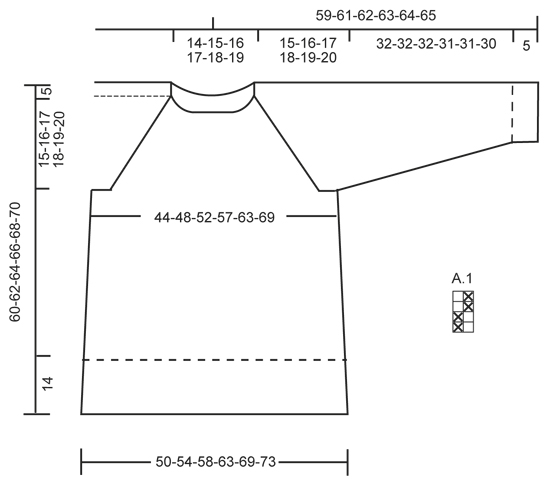 |
|||||||
Have you finished this pattern?Tag your pictures with #dropspattern #comeheresweater or submit them to the #dropsfan gallery. Do you need help with this pattern?You'll find 25 tutorial videos, a Comments/Questions area and more by visiting the pattern on garnstudio.com. © 1982-2025 DROPS Design A/S. We reserve all rights. This document, including all its sub-sections, has copyrights. Read more about what you can do with our patterns at the bottom of each pattern on our site. |
|||||||






















































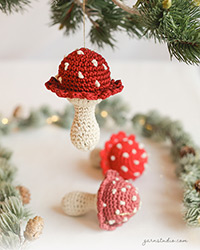
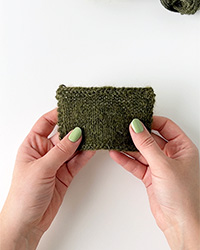

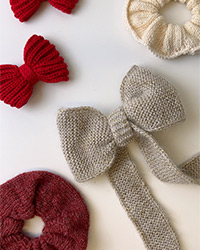
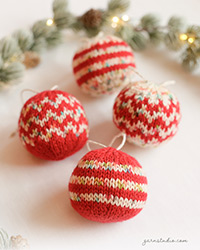

Post a comment to pattern DROPS 157-34
We would love to hear what you have to say about this pattern!
If you want to leave a question, please make sure you select the correct category in the form below, to speed up the answering process. Required fields are marked *.